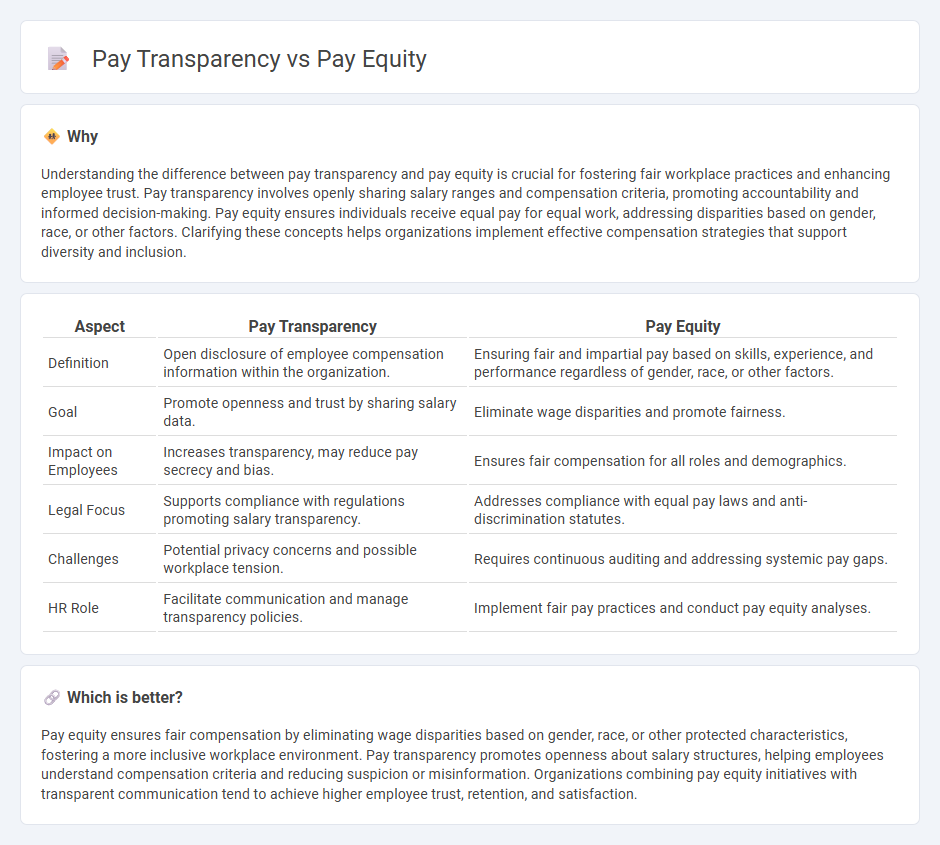
Pay transparency promotes openness about salary ranges and compensation structures within organizations, fostering trust and reducing wage disparities. Pay equity focuses on ensuring fair and unbiased remuneration regardless of gender, race, or other protected characteristics. Explore how aligning pay transparency with pay equity drives inclusive workplace culture and improves employee satisfaction.
Why it is important
Understanding the difference between pay transparency and pay equity is crucial for fostering fair workplace practices and enhancing employee trust. Pay transparency involves openly sharing salary ranges and compensation criteria, promoting accountability and informed decision-making. Pay equity ensures individuals receive equal pay for equal work, addressing disparities based on gender, race, or other factors. Clarifying these concepts helps organizations implement effective compensation strategies that support diversity and inclusion.
Comparison Table
| Aspect | Pay Transparency | Pay Equity |
|---|---|---|
| Definition | Open disclosure of employee compensation information within the organization. | Ensuring fair and impartial pay based on skills, experience, and performance regardless of gender, race, or other factors. |
| Goal | Promote openness and trust by sharing salary data. | Eliminate wage disparities and promote fairness. |
| Impact on Employees | Increases transparency, may reduce pay secrecy and bias. | Ensures fair compensation for all roles and demographics. |
| Legal Focus | Supports compliance with regulations promoting salary transparency. | Addresses compliance with equal pay laws and anti-discrimination statutes. |
| Challenges | Potential privacy concerns and possible workplace tension. | Requires continuous auditing and addressing systemic pay gaps. |
| HR Role | Facilitate communication and manage transparency policies. | Implement fair pay practices and conduct pay equity analyses. |
Which is better?
Pay equity ensures fair compensation by eliminating wage disparities based on gender, race, or other protected characteristics, fostering a more inclusive workplace environment. Pay transparency promotes openness about salary structures, helping employees understand compensation criteria and reducing suspicion or misinformation. Organizations combining pay equity initiatives with transparent communication tend to achieve higher employee trust, retention, and satisfaction.
Connection
Pay transparency fosters an environment where employees have access to salary information, which helps identify and address disparities. Pay equity ensures fair compensation across all demographics, reducing wage gaps based on gender, race, or other factors. Together, they promote organizational trust, employee satisfaction, and compliance with equal pay regulations.
Key Terms
Wage Gap
Pay equity addresses the systemic wage disparities based on gender, race, or ethnicity by ensuring equal compensation for equal work and qualifications. Pay transparency involves openly sharing salary information within an organization to promote fairness and accountability, which can help uncover and reduce the wage gap. Explore how combining pay equity initiatives with pay transparency strategies can effectively close the wage gap and foster workplace equality.
Salary Disclosure
Salary disclosure plays a crucial role in pay transparency by openly sharing compensation details within organizations, which helps identify and address pay equity gaps. Pay equity focuses on ensuring fair and equal pay for employees performing comparable work, whereas pay transparency emphasizes the openness and communication of salary information to foster accountability. Explore how salary disclosure policies can drive both pay equity and transparency for a more inclusive workplace.
Compensation Benchmarking
Compensation benchmarking plays a crucial role in both pay equity and pay transparency by providing objective salary data to align employee pay fairly across roles and demographics. Pay equity focuses on eliminating wage gaps due to gender, race, or other factors through the use of comprehensive compensation benchmarking tools. Explore how leveraging compensation benchmarking ensures transparent and equitable pay practices for your organization.
Source and External Links
Pay Equity: A Complete Guide 2025 - This article provides a comprehensive overview of pay equity, including its definition, importance, and best practices for implementation in organizations.
Pay Equity: What is it and Why is it Important? - This article explains the concept of pay equity, its significance in avoiding discrimination, and its impact on business operations and employee engagement.
Policies & Practices | Fair Pay P&G - Procter & Gamble's approach to fair pay involves transparent compensation policies, regular audits, and a commitment to equitable pay practices across different demographics.
 dowidth.com
dowidth.com